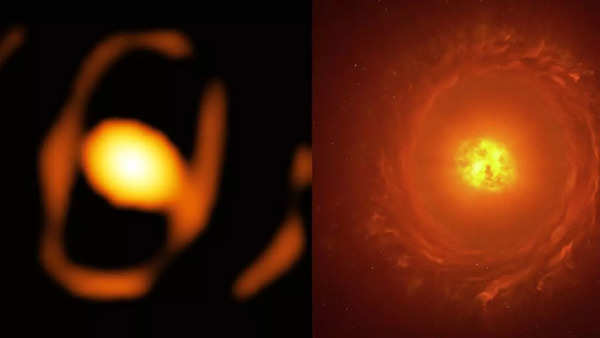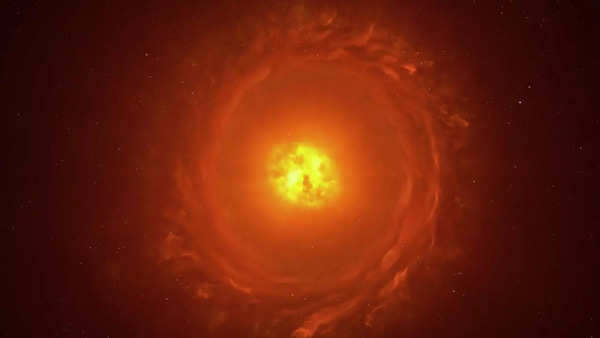
Astronomers have made a groundbreaking discovery by capturing the first detailed images of a star beyond our Milky Way galaxy. The star, WOH G64, is located 160,000 light years away in the Large Magellanic Cloud, a small galaxy orbiting the Milky Way. This massive red supergiant is about 2,000 times the size of the Sun and is undergoing a dramatic transformation. For the first time, scientists have observed an egg-shaped cocoon of gas and dust surrounding the star, hinting at significant changes taking place.
The cocoon may be a result of the star shedding its outer layers, potentially signaling its imminent death and the onset of a supernova explosion. Using the European Southern Observatory’s Very Large Telescope Interferometer (VLTI), astronomers were able to observe this distant giant in extraordinary detail, offering a rare glimpse into the life cycle of a star at the brink of its explosive end.

Image source: ESO.org
Astrophysicist Dr. Keiichi Ohnaka highlights key discovery of star’s imminent supernova potential
Dr. Keiichi Ohnaka, an astrophysicist at Andrés Bello National University in Chile, described the discovery as exciting, stating that the egg-shaped cocoon surrounding the star could be linked to the star shedding material before potentially exploding as a supernova.
The star in question, WOH G64, resides in the Large Magellanic Cloud, a small galaxy orbiting the Milky Way about 160,000 light years away. This red supergiant is thought to be one of the largest stars in the galaxy, measuring approximately 2,000 times the diameter of our Sun. Despite its immense size, observing this star in such detail required exceptional resolution, akin to spotting an astronaut walking on the Moon from Earth.

Image source: ESO.org
Significance of WOH G64’s transformation and its supernova potential explained
Dr. Jacco van Loon, a co-author of the study, explained that typical telescopes cannot provide this level of detail. The images reveal that the star has undergone significant changes in the last decade, shedding its outer layers and leaving behind the cocoon of gas and dust that now surrounds it. The star’s elongated shape may be the result of its rotation or the presence of an unseen companion star, influencing its structure. This transformation suggests that WOH G64 could be nearing the end of its life and may soon explode as a supernova. Dr. Van Loon compared the energy released by a supernova to the Sun shining for all its 10 billion years. While astronomers have observed supernovae in the past, they have never before witnessed a star changing in a way that signals its imminent death.

Image source: ESO.org
Stars are known to expel their outer layers shortly before a supernova explosion, a phenomenon that can happen in just a few years or decades. However, tracking these changes in real-time is rare. Van Loon noted that while it may still take tens of thousands of years for WOH G64 to reach its supernova stage, for astronomers, this is considered a relatively short timespan since stars live for millions or even billions of years.
Also Read | James Webb Space Telescope confirms Einstein zig-zag phenomenon, offering new insights into cosmology





















